

Follow this URL to current and past Bison information:
2006 BISON UPDATE:
On Bison Plans currently in discussion: Schweitzer has idea to keep cattle disease-free, and save money.
This story was written by SCOTT McMILLION of the Bozeman Daily Chronicle on March 26, 2006. If this works, Gov. Brian Schweitzer's new bison management proposal could save a lot of money. It could also help protect the state's brucellosis-free status for its beef herds, and it would give bison some more elbow room outside of Yellowstone National
Park. But making it work won't be easy.
In a nutshell, Schweitzer's plan calls for removing all cattle from public and private land in the Gardiner Basin on the north side of the park and in the West Yellowstone area, he said this week in a telephone interview.
This would be done by paying landowners a premium rate for their grazing rights. Private land grazing costs from $14 to $24 a month per cow/calf pair, which is known as an animal unit month or AUM.
"We'll give them $30 an AUM not to raise ruminants on that land," Schweitzer said.
About 740 cattle graze in what he called the "mixing zones" north and west of the park where bison and cattle could potentially come into contact. Only about 170 of them live there year round. The rest graze only in the summer.
Calculate the part-time and full-time bovines, and it works out to an equivalent of about 370 year-round cattle, he said. He calculates that buying out that grazing would cost about $100,000 a year. The current bison management system costs about $750,000 a year just for hazing bison back to the park, he said. In addition, it cost $200,000 to ship and slaughter nearly 1,000 bison over the recent winter, the busiest in a decade.
Leasing the grazing rights would cost about 15 percent of what the state is spending now, he said. In addition, eliminating cattle from the mixing zones would protect the economic interests of distant ranchers, who stand to lose money if cows near Gardiner or West Yellowstone come down with brucellosis, a disease carried by some of the bison. That's because current federal rules say that if cattle anywhere in a state come down with brucellosis, all breeding animals must undergo expensive tests before being shipped out of state.
"Why should somebody in Whitefish or Lewistown or Have put their brucellosis-free status at risk for those 370" cattle? he asked.
HUNTING, MIGRATING:
Schweitzer's proposal also calls for significantly increasing the role of hunters to manage bison, which means killing some.
Although the details remain to be worked out, the governor's idea is straightforward: When more bison come out, more hunters will be summoned. While the hunt likely would start small, "if more animals come out of the park, we'll draw another 100 tags, and another 100 tags, and then another," Schweitzer said. Plus, bison won't be allowed to wander forever.
"There will be a drop-dead zone," Schweitzer said. "We're not going to let them wander down the Madison Valley. We're not going to let them wander down the Yellowstone Valley."
The boundary likely will be somewhere around Yankee Jim Canyon north of the park and the Hebgen Lake Dam to the west. If bison go beyond those lines, it will be open season. Anybody could shoot them.
A similar strategy is in effect at Wood Buffalo National Park in Canada, where the bison also have disease issues.
Come spring, all bison would be hazed back into Yellowstone prior to calving season.
Schweitzer cited a report by Canadian bison expert Cormack Gates, which said that bison tend to return to areas where they give birth. While some describe bison movements as migrations, others say they are attempts at permanent emigration, that the park's animals have filled up their territory and are trying to recolonize ancient turf. But that turf is now filled, to one degree or another, with people,ranches, towns,
highways, irrigation systems and crops. Bison could wreak havoc on a lot of that.
"All the land they're heading for is private land," said John Mundinger, a retired FWP official with many years of experience with bison issues.
Even beyond brucellosis - a tough nut to crack on its own - bison aren't always easy neighbors. Between one and 10 Yellowstone visitors are injured by them yearly, according to the book "Death in Yellowstone," by park historian Lee Whittlesey.
"Probably the current potential for injuries and deaths from bison in the park is much greater that it is for bears," Whittlesey wrote.
Schweitzer said he'd like to pursue his plan on a 10-year time frame. That would give scientists and land managers time to work on vaccines, elk feed grounds in Wyoming and other brucellosis issues.
"Then we'll look at it again in 10 years," he said. "What we're doing now doesn't make any sense. It's not good management."
DEVILISH DETAILS:
The plan sounds simple: give bison more - but still limited - room to act like wildlife, engage the hunting public, reduce any risk to cattle - real or perceived - and save some taxpayer dollars.
"We're going to hunt them in the winter and we'll chase them back into the park in the summer," Schweitzer said. But there are a million details to be worked out, a variety of interest groups to be accommodated.
Still, a wide variety of people say they're at least intrigued by Schweitzer's plan. Some are downright enthusiastic.
"At this point, we're open to any and all debate," said Bill Donald, president of the Montana Stockgrowers Association, though that group's
official policy prefers to focus on elimination of brucellosis.
"It's a pretty complex issue and we'll never come to a solution if we don't start talking," he added.
"It's exciting that we're to the point where people, and the governor in particular, are putting practical solutions on the table," said Amy McNamara, of the Greater Yellowstone Coalition.
"It's going to be a challenge, but this is a real positive step," said Stephany Seay, of the Buffalo Field Campaign.
Schweitzer dismisses any implication that he's catering to bison advocates instead of stockgrowers.
"Please," he said. "I'm the first cattleman elected governor since
1916." He grew up on a ranch and runs cattle near Whitefish.
Only about four people run cattle on private land in the West Yellowstone area and a similar number do so on the north side. Federal grazing allotments near West Yellowstone also allow about 100 cow/calf pairs in the summer. But the owners all have their own interests. Few make a living from cattle, but some use them as management tools and have invested heavily
in improvements with cattle in mind.
Hank Rate, who has a history of wildlife advocacy, runs 20 cows on a 70-acre parcel north of Corwin Springs. He said he's had bison on his property in the past, as well as bears and mountain lions, but didn't
have problems. But each of those cows was born on his place, he said, and his family values the lifestyle of raising cattle.
"They're part of the family, too," he said of his cows.
Selling his grazing rights for 10 years would put him out of the cow business permanently, he said, and that doesn't appeal to him. If he's going out of business, he'd rather sell a conservation easement for
wildlife, he said.
The biggest cattle operator in the region is the Church Universal and Triumphant at Corwin Springs.
Pat Flowers, regional manager for the Montana Department of Fish, Wildlife and Parks, has been negotiating with church officials, trying
to work out some kind of deal that would give bison more room. (A $13 million U.S. Forest Service deal in 1999 bought land from the church, but the church retained the grazing rights.)
Most of the bison slaughtered this winter died because they were heading for the church's pastures, where about 150 cattle graze.
The negotiations, Flowers said, center around "how to allow bison to use (the ranch) in a way that's not going to cause big problems for them as
landowners."
Possible solutions include leases, temporary fencing around sensitive areas, and other measures, he said.
"Hopefully, we can work through all the details on this," he said. "Initially, all the solutions seem really simple. Then, you start peeling the onion and it's not so simple." Still, Schweitzer's proposal is a start.
The Racicot and Martz administrations relied on lawsuits and court-ordered negotiations to come up with the existing plan, which resulted in the roundup and slaughter of all those bison this year.
"This is a huge first step" in coming up with something better, Seay
said.
And there might be a longterm upside to this year's heavy slaughter.
"By taking 1,000 bison out, we might have bought a couple years worth of time to work out a better solution," Mundinger said.
Schweitzer said he looks forward to working with people, trying to hammer out a better plan, where bison get to roam, cattle are protected and people who give something up such as grazing rights - are
compensated.
THE BISON OF NORTH AMERICA:
The bison of North America has its natural habitat as the prairie and open woodland. Millions of bison roamed the North American grasslands until European settlers brought them almost to extinction by the beginning of the twentieth century. The American Bison society fought to re-establish the reserves, where they live today in a semi-wild state. These herds are at Yellowstone and Custer State parks. Now the bison number well over 20,000.
Being primarily grazing bovids, Bison live in herds that vary from a family group to several thousand. They then migrate in search of better pastures. Bison feed in the morning and evening, and during the day they rest in "Buffalo wallows" or dust themselves to rid their coats and eyes of flies and other parasites. In the winter, Bison thrive and being a hearty breed, their coats thicken and are prized.
Mating season begins in the fall and continues through January - this is the only time bulls fight for cows, which give birth to a single calf, away from the herd. Bison's gestation period is nine (9) months, the same as humans. Calves are generally able to join the herd within an hour or two after birth. This is when the cow's become aggressive (when protecting their calves), Calves are suckled for about a year and they remain with their mother until they reach sexual maturity at about three (3) years of age (Whitfield, Dr, Phillip (editor), MacMillian Illustrated Animal Encyclopedia. New York: MacMillian Publishing Company, 1984). Both the bulls and the cows have horns. When defending against danger, the cows will form a defensive circle around the calves, and the bulls will form a circle around the cows. While this worked well against wolves, it was a poor defense against humans who shot them for their hides and tongues or for sport. There were once three different species of Bison in the USA, numbering an estimated 50 million. By 1906, there were only about 800 Plains Bison left, now there are over 50,000. However, the Wood and Eastern Bison are extinct.
When Bison were near, the people would eat, and would have tools, fur for clothing, and hides for shelter. No part of the Bison was wasted (Lake-Thom, Bobby, Spirits of the Earth. Buffalo was a good sign, a strong power, and a messenger of strength. New York: A Plume Book, 1997).
In Lakota culture, there is a ceremony that must be followed before you can take the life of a Buffalo (Bison) - the Buffalo Kill Ceremony. Prayers are offered and they talk to the Bison and its spirit ("Saving Yellowstone's Buffalo" by Winona LaDuke, Native Peoples Magazine, Fall 1998, 50).
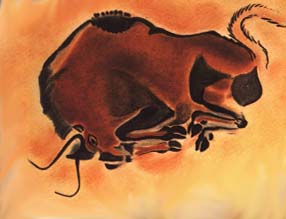
EUROPEAN BISON:
European bison (Bison bonasus) are much the same size as our American Bison, however, they do not have as splendid a coat and are not as powerful looking. Many American Bison have been bred in Europe now (there is a large herd in Germany).
The European Bison lives mostly on reserves in Poland (3 reserves) and the former USSR (11). The largest herd in Poland is in Bialowieza Forest on their border. The lack of forests have left the European Bison without their diet of leaves, ferns, twigs, and bark. They also like acorns in autumn.
Through the efforts of conservationists this animal is still alive today.
THE GREAT PLAINS:
Fifty million Bison roamed the Great Plains in the past. In Ecography magazine they reported: "The prehistoric cycle of grassland, fire, aspen suckering, bison activity, and return to grasslands was interupted by the removal of bison, allowing aspen expansion..." The destruction of this ecological cycle set forth both an ecological and economic crisis. Topsoil is now eroding and groundwater is dwindling. Original grasses have been destroyed.
Brucellosis is the reason Bison are being killed (20-40% of Yellowstone Buffalo have it). Cattlemen fear it will transfer to cattle - although research is to the contrary. Disease doesn't tranfer that easily. Elk are more likely to transmit the disease than Bison. Elk make Montana $11 million in hunting licenses and fees, so they are spared.
BISON LINKS:
Bison meat is touted as a "health food" because of its cholesterol and fat levels. Jane Fonda and Ted Turner have one of the largest buffalo herds in the USA.
BISONS ALMOST BECOME EXTINCT:
At the turn of the century, Bison were almost made extinct in the U.S.A., and the only place where the buffalo still roam in Europe, is in Poland. However, their bones have been discovered in the superficial strata of temperate Europe. Bison were common in Germany in the 8th century
BISON ON PRESERVES IN YELLOWSTONE PARK ARE BEING KILLED DAILY ... STOP THE SLAUGHTER!!!:
Native Americans all think of the Bison as one of the most powerful sacred creatures, because the bison provided everything they needed (food, shelter and clothing).
THE WHITE BUFFALO:
A white buffalo or white bison is an American bison possessing white fur, and is considered sacred or spiritually significant in several Native American religions; therefore, such buffalo are often visited for prayer and other religious rituals. The coats of buffalo are almost always brown and their skin a dark brown or black; however, white buffalo can result from one of several physical conditions:
They may be albinos, in which case they will remain unpigmented throughout their lives, and may also have hearing and vision problems.
White buffalo are extremely rare; the National Bison Association has estimated that they only occur in approximately one out of every 10 million births.
Buffalo-bison.com list of ranches.
A White Buffalo Calf was born in September 1999 at the Double RR Bison Ranch in Ogemaw County, Michigan. Earl Roe, the owner says this was the second white calf born to the same mother in three years. The first one was born in 1997. The calf is called "White Lightning" (Michigan Indian Quarterly Winter 1999, published by the Michigan Department of Civil Rights)
The Kota Territory News reported that a White Buffalo was born on the ranch of Jim and Dena Riley near Belle Fourche. The new bison was the offspring of "Miracle Moon," another White Buffalo born three years ago. The new bison is named "Rainbow Spirit."
More information about Rainbow Spirit and other white bison.
In Cowboys and Indians Magazine, November 1998 there is an update on Miracle, the most famous White Buffalo Calf. Miracle was born in Wisconsin in 1994. Miracle changed to black in January 1995, red in June 1995, then yellow in November 1995. Today Miracle is a healthy blonde bison and she has given birth to a yellow buffalo calf. Sadly, Miracle died on September 19, 2004. Dave, Val, and Corey Heider own the farm where Miracle was born:
White Miracle ... White Buffalo Calf Woman
On May 9, 1996, a silvery-white buffalo calf named Medicine Wheel was born at the ranch of Joe Merrival on the Pine Ridge Reservation in South Dakota. Another white calf, Rainbow, had been born to the same herd on April 27, 1996. Rainbow died 25 hours later of scours, a diarrhea-type condition. The first White Buffalo seen in this century was born in Colorado in 1933, according to Cowboys and Indians Magazine.
Medicine Wheel (May 9, 1996-March 2000) was shot at Pine Ridge Reservation (Native Peoples: Arts & Lifeways, June/Jul 2000, 16). This tragic event was reported as: "Medicine Wheel was killed in March in Red Cloud, South Dakota, on the Pine Ridge Indian Reservation. The buffalo was found by law-enforcement personnel wandering the streets at night and was shot to death." This event followed a series of events, such as the occupation of the tribal administration building, last summer's heated marches on nearby Whiteclay, Nebraska, to protest beer sales and a spate of unsolved Indian murders.
Why Medicine Wheel was out in the town was not reported, nor was the reason for the shooting (Some say it was because she was attacking people in town). She should have been easily identified in the dark by her white color. Whether there was related violence is also unreported.
This bison died.
White Buffalo Calf
On July 29, 1998, a White Buffalo calf named Spirit Walker was born at Child's Place Ranch in Hanover, Michigan. Unfortunately, this female calf died on August 15, 1998. Shaman have predicted that Child's Place will have another such birth in the future. A memorial stone marker has been erected to honor this calf.
Childs Place is located at:
They may be leucistic, with white fur but blue eyes, instead of the pink seen in albinos.
They may have a rare genetic condition which causes a buffalo to be born white, but to become brown within a year or two as it matures.
They may be beefalo, a bison–cattle crossbreed, and thus have inherited the white coloration from their cattle ancestry.Those Born in the Last Ten Years in the United States:
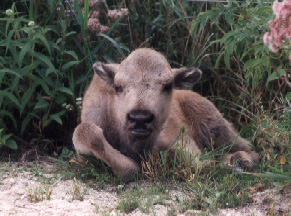
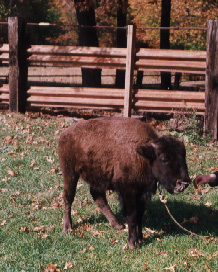
Mr T (Tatanka) 1995 (Photo taken by Margaret Sypniewska at Child's Place Ranch)
Shows the color of a normal calf
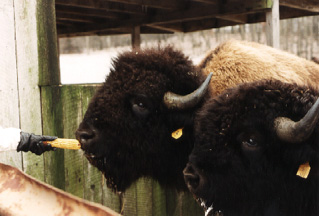
Child's Place has a General Store that is open from 9 a.m. - 4 p.m. daily, except Mondays and Holidays. They sell bison meat and bison products.
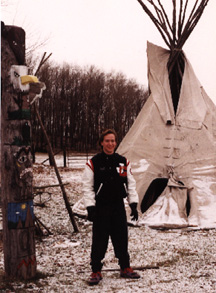

April 17, 2005 - Spirit of Peace is born on Blatz Bison Ranch, Fort John, British Columbia, Canada:
The White Buffalo, called Spirit of Peace (Website).
On Thursday, July 21, 2005 Animal Planet.com there an article saying: "This is the first white calf that was born in Canada. I know there were a few in the States, but not a lot," rancher Karen Blatz told AFP.
The birth of a white buffalo calf is seen by Native Americans as a most significant prophetic sign, equivalent to weeping statues, bleeding icons, and crosses of light that are becoming prevalent within the Christian Church. Native Americans see the White Buffalo Calf as a sign which will mend life's sacred hoop.
The first White Bison born in the last ten years was Miracle, born on the Heifer farm in Wisconsin, Miracle died September 19, 2004. Floyd Hand Looks For Buffalo, an Ogala medicine man has commented: "Here is a man (Dave Heider), a poor farmer, who has been kind to animals all his life, and now there is a white buffalo calf here. These are omens and they are happening in the most unexpected places among the poorest people in the business."
